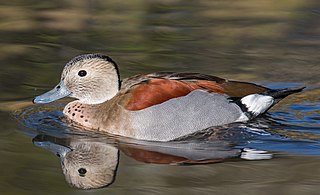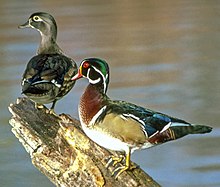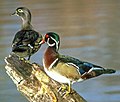
The Anatidae are the biological family of water birds that includes ducks, geese, and swans. The family has a cosmopolitan distribution, occurring on all the world's continents. These birds are adapted for swimming, floating on the water surface, and in some cases diving in at least shallow water. The family contains around 174 species in 43 genera.

The Anatinae are a subfamily of the family Anatidae. Its surviving members are the dabbling ducks, which feed mainly at the surface rather than by diving. The other members of the Anatinae are the extinct moa-nalo, a young but highly apomorphic lineage derived from the dabbling ducks.

The Tadorninae is the shelduck-sheldgoose subfamily of the Anatidae, the biological family that includes the ducks and most duck-like waterfowl such as the geese and swans.

The gadwall is a common and widespread dabbling duck in the family Anatidae.
The perching ducks were previously treated as a small group of ducks in the duck, goose and swan family Anatidae, grouped together on the basis of their readiness to perch high in trees. It has been subsequently shown that the grouping is paraphyletic and their apparent similarity results from convergent evolution, with the different members more closely related to various other ducks than to each other.

The wood duck or Carolina duck is a species of perching duck found in North America. It is one of the most colorful North American waterfowl.

The mandarin duck is a perching duck species native to the East Palearctic. It is medium-sized, at 41–49 cm (16–19 in) long with a 65–75 cm (26–30 in) wingspan. It is closely related to the North American wood duck, the only other member of the genus Aix. Aix is an Ancient Greek word which was used by Aristotle to refer to an unknown diving bird, and galericulata is the Latin for a wig, derived from galerum, a cap or bonnet.

The ferruginous duck, also ferruginous pochard, common white-eye or white-eyed pochard is a medium-sized diving duck from Eurosiberia. The scientific name is derived from Greek aithuia an unidentified seabird mentioned by authors including Hesychius and Aristotle, and nyrok, the Russian name for a duck.

The ruddy shelduck, known in India as the Brahminy duck, is a member of the family Anatidae. It is a distinctive waterfowl, 58 to 70 cm in length with a wingspan of 110 to 135 cm. It has orange-brown body plumage with a paler head, while the tail and the flight feathers in the wings are black, contrasting with the white wing-coverts. It is a migratory bird, wintering in the Indian subcontinent and breeding in southeastern Europe and central Asia, though there are small resident populations in North Africa. It has a loud honking call.

The knob-billed duck, or African comb duck, is a duck found in tropical wetlands in Sub-Saharan Africa, Madagascar and the Indian Subcontinent from northern India to Laos and extreme southern China.

The comb duck or American comb duck, is an unusual duck, found in tropical wetlands in continental South America south to the Paraguay River region in eastern Paraguay, southeastern Brazil and extreme northeastern Argentina, and as a vagrant on Trinidad.

The crested shelduck, or Korean crested shelduck, is a species of bird in the family Anatidae. It is critically endangered and may be extinct. The male crested shelduck has a greenish-black crown, breast, primaries, and tail, while the rest of its face, chin, and throat are brownish black. The male's belly, undertail coverts, and flanks are a dark grey with black striations. The upper wing coverts are white, while its speculum is an iridescent green. The female has a white eye ring, black crest, white face, chin, throat, neck, and uppers wing coverts and a dark brown body with white striations. Additionally, both sexes have a distinctive green tuft of feathers protruding from the head.

The falcated duck or falcated teal is a gadwall-sized dabbling duck from the east Palearctic

The Australian wood duck, maned duck or maned goose is a dabbling duck found throughout much of Australia. It is the only living species in the genus Chenonetta. Traditionally placed in the subfamily Anatinae, it might belong to the subfamily Tadorninae (shelducks); the ringed teal may be its closest living relative.

The blue-winged goose is a waterfowl species which is endemic to Ethiopia. It is the only member of the genus Cyanochen.

The blue duck or whio is a member of the duck, goose and swan family Anatidae endemic to New Zealand. It is the only member of the genus Hymenolaimus. Its exact taxonomic status is still unresolved, but it appears to be most closely related to the tribe Anatini, the dabbling ducks.

The African black duck is a species of duck of the genus Anas. It is genetically closest to the mallard group, but shows some peculiarities in its behavior and plumage; it is accordingly placed in the subgenus Melananas pending further research.

The white-winged duck or white-winged wood duck is a large species of duck, formerly placed in the genus Cairina with the Muscovy duck and allied with the dabbling ducks. However, mtDNA cytochrome b and NADH dehydrogenase subunit 2 sequence analysis indicate that the anatomical similarity to the Muscovy duck is deceiving and that the species is appropriately placed in a monotypic genus, as Asarcornis scutulata, which is evolutionarily closer to the redhead.

The ringed teal is a small duck of South American forests. It is the only species of the genus Callonetta. Usually placed with the dabbling ducks (Anatinae), this species may actually be closer to shelducks and belong in the subfamily Tadorninae; its closest relative is possibly the maned duck.

Hartlaub's duck is a dark chestnut-coloured duck of African forests. Formerly included in the paraphyletic "perching duck" assemblage, it was later moved to the dabbling duck assemblage. However, it is fairly distinct from the "typical" dabbling ducks, and is placed in the monotypic genus Pteronetta to reflect this.





















